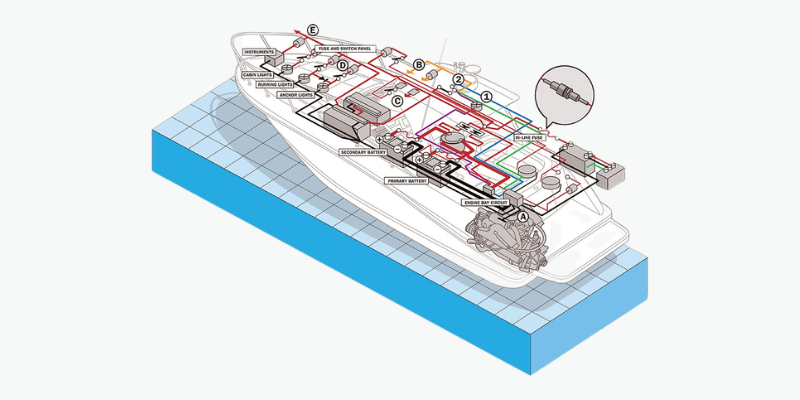Betrouwbare stroom is van vitaal belang voor de veiligheid van de zee. Of u nu vist, cruisen of op zee werkt, het onderhouden van de elektrische systemen van uw boot is essentieel. Bekijk dit artikel voor handige varenveiligheidstips om ervoor te zorgen dat uw stroombronnen soepel lopen. We behandelen alles, van veel voorkomende elektrische gevaren tot de beste manieren om voor uw batterijen te zorgen.
Inzicht in de elektrische veiligheid van mariene
Bootelektrische systemen kunnen ingewikkeld zijn, met verschillende stroombronnen en hoogspanningsapparatuur die speciale zorg vereist. De natte omgeving en het gebrek aan goed onderhoud kunnen leiden tot galvanische corrosie.
Kwesties zoals kort circuits, schokken, branden en elektrische storingen kunnen snel gevaarlijk worden vanwege beperkte ontsnappingsopties. Inzicht in de elektrische veiligheid van mariene, zoals de juiste bedrading en regelmatig onderhoud, kan deze risico's helpen identificeren en verminderen.
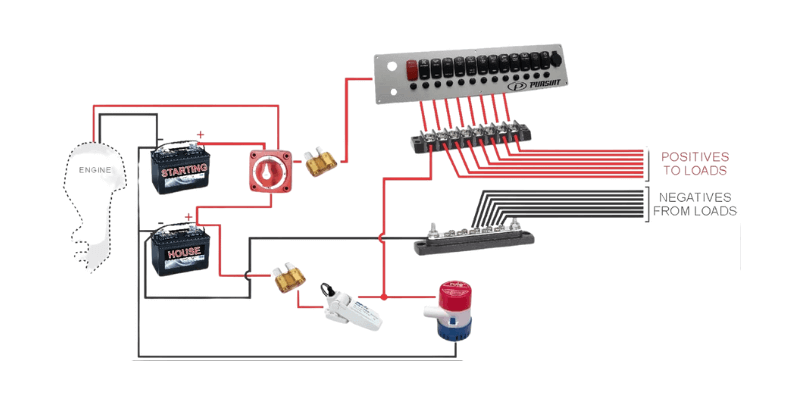
Veel voorkomende elektrische gevaren op schepen
Veel watersporters kijken vaak over de gevaren zoals overbelaste circuits, het verwaarlozen van bedradingonderhoud en het hebben van water te dicht bij elektrische componenten. Deze problemen kunnen snel de veiligheid in gevaar brengen als ze niet zorgvuldig worden aangepakt.
Overbelaste circuits
Als u meer apparaten toevoegt, overweeg dan hun totale stroomgebruik. Overbelaste draden en brekers kunnen korte broek of zelfs branden veroorzaken.
Het is verstandig om de totale stroomsterkte voor al uw elektrische apparaten te berekenen en ervoor te zorgen dat uw bedrading en brekers het aankunnen.
Vermijd ook daisy-chaining power strips of overladende verkooppunten, vooral als uw plaats oudere bedrading heeft die de elektronica van vandaag mogelijk niet goed aanpakt.
Water en elektrische componenten
Zoutwater kan elektriciteit dragen, dus zelfs kleine morsen kunnen leiden tot kortsluiting of roest.
Zorg ervoor dat alle elektrische onderdelen rechts worden afgesloten en blijf bij de uitrusting van de zee om water buiten te houden. Vergeet niet om apparaten los te koppelen wanneer ze niet worden gebruikt.
Als water binnenkomt, snijdt u onmiddellijk de stroom af, drogen alles grondig en inspecteer het voordat u het gebruik hervat.
Slecht onderhouden of oude bedrading
De mariene omgeving kan het elektrische systeem van uw boot geleidelijk beschadigen vanwege blootstelling aan zoutwater en UV. Kijk uit voor waarschuwingssignalen zoals hete verkooppunten, defecte schakelaars, flikkerende lichten bij het gebruik van apparaten, frequente brekerreizen of brandende geuren die gesmolten isolatie aangeven. Regelmatig onderhoud is essentieel om het elektrische systeem van uw boot veilig te houden en soepel te werken.
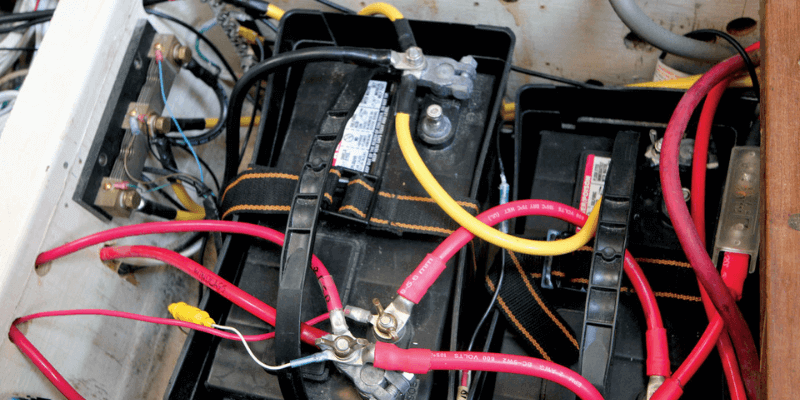
Basis voorzorgsmaatregelen voor mariene veiligheid
Het verzorgen van uw boot houdt in dat u op de hoogte blijft van het onderhoud van het elektrische systeem. Regelmatige check-ups zorgen voor veiligheid, betrouwbaarheid en soepele werking voor de lange termijn.
Het belang van regelmatige inspecties
Naarmate de elektrische componenten ouder worden, kunnen hun prestaties afnemen. Tijdige inspecties en reparaties helpen bij het handhaven van piekefficiëntie en verlengen de levensduur van uw elektrische systeem, waardoor dure vervangingen worden voorkomen.
Professionele installatie
Een goede installatie door een gekwalificeerde mariene elektricien is belangrijk voor veiligheid en naleving. Hoewel het doe -het -zelf in eerste instantie geld kan besparen, verbetert professionele installatie de prestaties, vermindert het gedoe onderhoud en verhoogt de wederverkoopwaarde van uw boot.
Professionals houden zich aan veiligheidsprotocollen met behulp van mariene componenten om risico's te verminderen en tegelijkertijd de naleving van de voorschriften te waarborgen. Een goed gedocumenteerde installatie kan de wederverkoopwaarde aanzienlijk verbeteren; Kopers geven de voorkeur aan boten met een betrouwbare elektrische geschiedenis.
Het gebruik van de juiste materialen voor mariene toepassingen
Elektrische systemen op boten worden geconfronteerd met harde omgevingen. Het gebruik van geschikte materialen is fundamenteel voor veiligheid en levensduur:
- Corrosiebestendigheid: kies materiaal die bestand zijn tegen zoutwater.
- Waterdichting: zorg ervoor dat elke verbinding waterdicht is om kortsluiting te voorkomen; Warmte krimpende slang is hier effectief.
- Trillingsweerstand: gebruik duurzame componenten die constante beweging kunnen doorstaan.
- Temperatuurtolerantie: kies voor materialen die extreme temperaturen aankan.
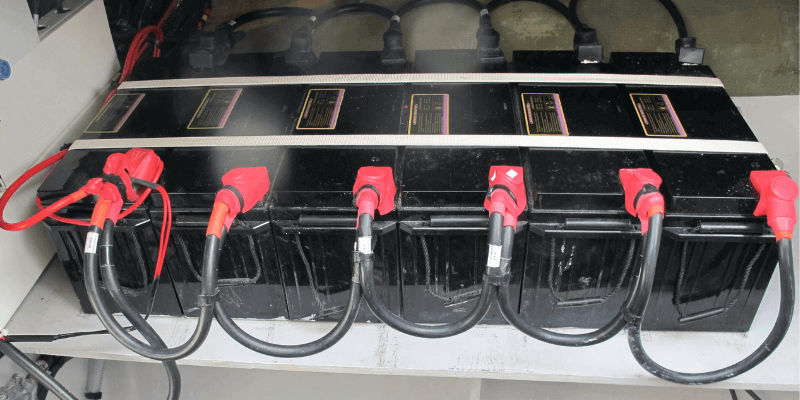
Belangrijkste veiligheidstips voor elektrische mariene systemen
We hebben verschillende tips voor de veiligheid van de zee besproken, maar het moet een paar belangrijke punten onthouden, vooral bij het hanteren van meerdere stroombronnen.
Batterijveiligheid
U moet de batterijen van loodzuren controleren omdat ze na verloop van tijd verslijten en afbreken. Als ze onder de 50% capaciteit vallen, kunnen ze gesulfeerd raken, wat de gezondheid van de batterij schaadt.
Holo -batterijen daarentegen Aangepaste lithiumbatterijen kan volledig worden ontslagen zonder hun levensduur te beïnvloeden.
Bovendien vereisen loodzuursystemen een goede ventilatie, omdat ze tijdens het gebruik opwarmen, terwijl lithiumbatterijen stabieler zijn en geen strikte locatievereisten hebben voor veiliger gebruik.
Batterijveiligheid Best practices
Hier zijn enkele tips om de veiligheid en prestaties van uw mariene batterijen te verbeteren:
- Houd terminals en verbindingen schoon en corrosievrij; Inspecteer regelmatig.
- Gebruik een oplader van de zee die specifiek is voor uw batterijtype.
- Vermijd overladen; Volg de richtlijnen van de fabrikant.
- Bewaar batterijen in een koele, geventileerd gebied uit direct zonlicht.
- Kies lithiumbatterijen met een Batterijbeheersysteem (BMS) met bescherming met een laag spanning.
- Verwijder de batterijen als de temperatuur onder -15 ° F daalt; Bewaar ze warm.
- Volledig opladen voor uitgebreide opslag, loskoppelen van alle stroombronnen en het verwijderen van de negatieve lead.
- Gebruik compatibele batterijen voor uw apparaten om lekkage te voorkomen.
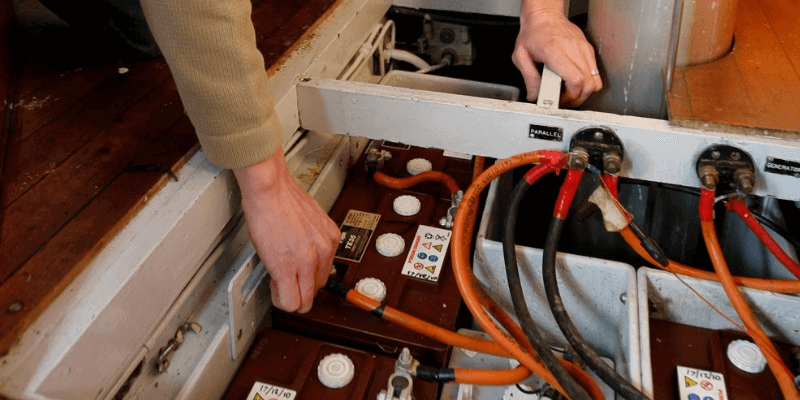
Bedrading en verbindingen
Vermijd onopgemerkt bedrading door deze praktijken te volgen:
- Gebruik alleen bedrading en connectoren van maritieme kwaliteit; Huishoudelijke of auto-bedrading is mogelijk niet waterdicht of corrosiebestendig.
- Controleer de bedrading regelmatig op schade of vochtafbraakborden zoals gerafelde isolatie of losse verbindingen.
- Zorg ervoor dat alle stroomverbindingen veilig zijn tegen de elementen.
- Correct gemalen elektrische componenten om zwerfstromen te voorkomen – Raadpleeg indien nodig een gekwalificeerde elektricien.
- Vermijd het routeren van draden door watergevoelige gebieden zoals bilges.
- Installeer stroomonderbrekers of zekeringen om te beschermen tegen korte circuits en overbelastingen die branden kunnen veroorzaken.
- Regelmatig schone terminals en verbindingen om corrosie te voorkomen.
- Label draden duidelijk voor eenvoudiger onderhoud.
Monitoring en onderhoud
Regelmatig onderhoud en monitoring voorkomen kostbare reparaties en zorgen voor een veilige werking:
- Beveilig alle terminals en splits om de verbindingsintegriteit te controleren.
- Test regelmatig batterij laadniveaus, spanning en algehele gezondheid.
- Bevestig dat de Bilge -pomp correct werkt met geluid Elektrische verbindingen.
- Zorg ervoor dat schakelaars, stroomonderbrekers en besturingsapparaten correct werken voor systeembeveiliging.
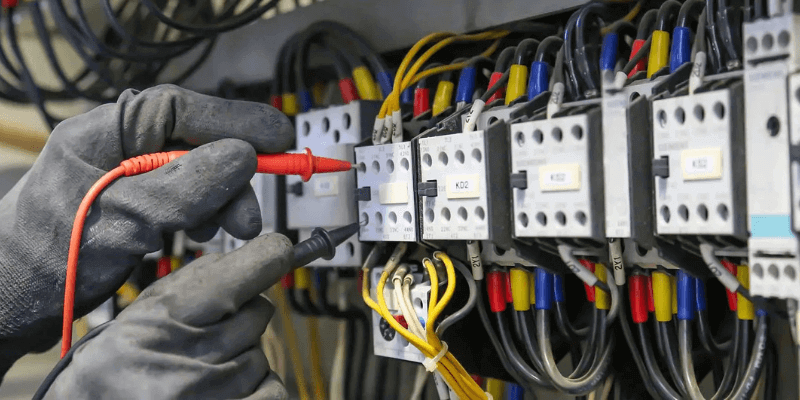
Holo Battery's Marine Safety Solutions
Bij Holo Battery geven we prioriteit aan veiligheid, kwaliteit en geavanceerde technologie in onze oplossingen voor mariene batterijen. We ontwerpen en monteren onze batterijpakketten met eersteklas veiligheidsnormen in de industrie door:
- Rigoureus testen
- Certificeringen van derden in overeenstemming met ABYC-normen
- Geavanceerde kwaliteitscontrole
We gebruiken lithiumijzerfosfaat (LifePo4) voor de uitstekende veiligheidsvoorzieningen, inclusief uitzonderlijke thermische stabiliteit en weerstand tegen thermische vluchteling. LIFEPO4 biedt ook een lange levensduur van de cyclus voor betrouwbare diepe cycluste -toepassingen.
Onze lithium-ionbatterijen vereisen geen onderhoud en bieden een langere levensduur door geleidelijk vermogen vrij te geven, waardoor de oplaadfrequentie wordt verminderd. Ze zijn lekbestendig, recyclebaar en rookvrij.
Onze slimme technologie bewaakt spanning, huidige belasting, batterijgezondheid, temperatuur, systeembalans en meer, het verbeteren van de veiligheid. Het maakt nauwkeurige op afstandsmonitoring van individuele LIFEPO4 -batterijen en accessoires mogelijk.

